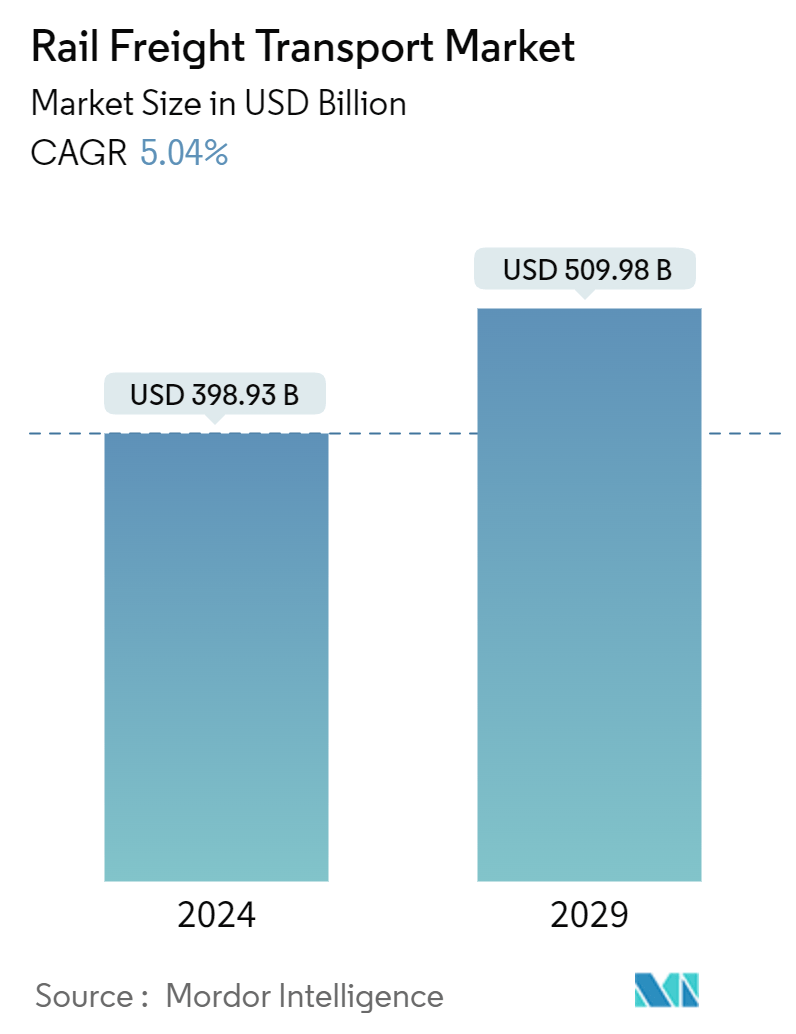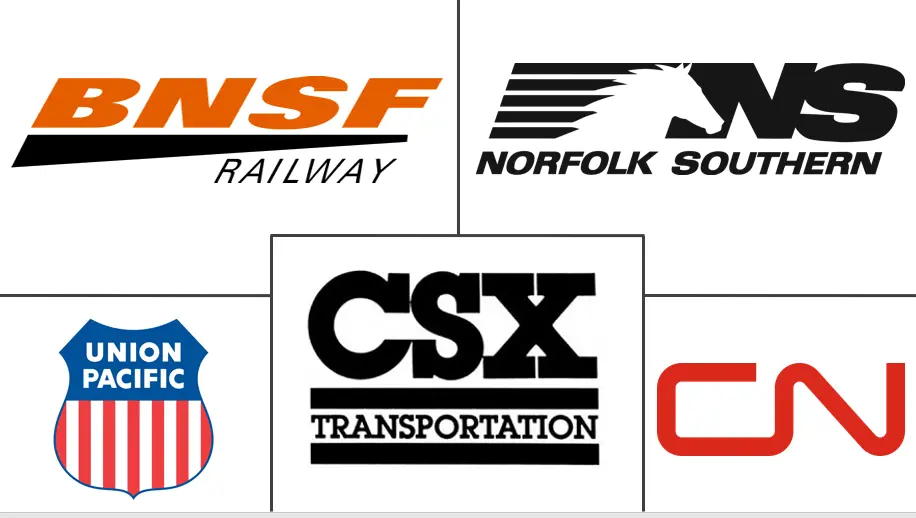Market Size of Rail Freight Transport Industry

| Study Period | 2020 - 2029 |
| Market Size (2024) | USD 398.93 Billion |
| Market Size (2029) | USD 509.98 Billion |
| CAGR (2024 - 2029) | 5.04 % |
| Fastest Growing Market | Asia Pacific |
| Largest Market | Asia Pacific |
Major Players
*Disclaimer: Major Players sorted in no particular order |
Rail Freight Transportation Market Analysis
The Rail Freight Transport Market size is estimated at USD 398.93 billion in 2024, and is expected to reach USD 509.98 billion by 2029, growing at a CAGR of 5.04% during the forecast period (2024-2029).
Intermodal transportation, which involves the use of multiple modes of transportation (e.g., rail and truck), has been gaining popularity. Railroads play a key role in intermodal logistics, offering an efficient and cost-effective solution for moving freight over long distance. Several significant factors, such as the growth of the world's population and continued urbanization, which contribute to an increasing demand for rail freight services, strongly influence market growth.
Artificial intelligence's power is harnessed by leading players in the rail freight market to provide accurate analysis, real-time transport operations, traffic planning, and predictive operation. Artificial intelligence is essential in optimizing rail operations, increasing capacity, and improving efficiency.
The Indian Railways carried more than 1.42 billion tonnes of freight in the financial year 2022. It was in the same category as road transport, with the 2nd most significant share of the freight logistics industry. Freight transport depends on land modes in a country with many metropolitan areas and inland states.
In 2022, the EU rail freight transport for central undertakings (total volume of goods transported of at least 200 million tonne-kilometres or at least 500 000 tonnes) reached 398 billion tonne-kilometres (tkm), almost at the level registered in 2018.
The US railroads produced 1,128,573 carloads in November 2023, a decrease of 102 cars compared to the same month last year. The AAR reported that in November 2023, 1,279,906 containers and trailers were hauled by US railroads, an increase of 60,486 units or 5% compared to November 2022.
In July 2023, AI-enabled software was launched by RailVision Analytics, Canada's leading rail industry software company, that enables locomotive engineers to make minor adjustments for train operation and save significantly on fuel costs. This innovative technology supports efforts to reduce greenhouse gas emissions from freight and passenger trains.
In addition, Rail freight transport is critical in supporting a country's economic performance due to its paramount role in ensuring a seamless and efficient flow of goods locally and across borders. Rising freight volumes, infrastructure development, and adoption of sophisticated technology drive market growth. The market growth is fueled by technological advances and efforts by various countries, such as China, to boost rail freight volumes to curb pollution.
Given the huge pollution contribution of this sector, it has become a major imperative to reduce carbon emissions in freight transport. Depending on the geography, state of infrastructure and availability of fuel, the modal split between freight transport is different. A modal shift from road to rail could be part of concerted action in India. The challenges of attracting more cargo to train with a focus on expanding the railway network have been progressively addressed by Indian Railways and its subsidiary companies.
Rail Freight Transportation Industry Segmentation
Transportation by railway is a much more reliable form of moving cargo since the transit of goods is unaffected by weather conditions like rain, storm, or fog. Additionally, rail freight is way more punctual than trucking, and air shipments can only surpass its punctuality.
A complete background analysis of the Rail Freight Transportation market, including the assessment of the economy and contribution of sectors in the economy, market overview, market size estimation for key segments, and emerging trends in the market segments, market dynamics, and geographical trends, and COVID-19 impact, is covered in the report.
The market is segmented by cargo type (containerized (intermodal), non-containerized, and liquid bulk), destination (domestic and international), service type (transportation and services allied to transportation), and geography (North America, Europe, Asia-Pacific, and Rest of the World). The report offers the market size and forecasts in value (USD) for all the above segments.
| By Type of Cargo | |
| Containerized (Includes Intermodal) | |
| Non-containerized | |
| Liquid Bulk |
| By Destination | |
| Domestic | |
| International |
| By Service Type | |
| Transportation | |
| Services Allied to Transportation (Maintenance of Railcars and Rail Tracks, Switching of Cargo, and Storage) |
| By Geography | |||||||
| |||||||
| |||||||
| |||||||
|
Rail Freight Transport Market Size Summary
The rail freight transport market is poised for significant growth over the forecast period, driven by the increasing demand for efficient and cost-effective logistics solutions. Intermodal transportation, which integrates rail with other modes like trucking, is becoming increasingly popular due to its ability to optimize long-distance freight movement. The market is influenced by factors such as global population growth, urbanization, and technological advancements, particularly the integration of artificial intelligence to enhance operational efficiency and capacity. Rail freight plays a crucial role in supporting economic performance by ensuring a seamless flow of goods both locally and internationally. The sector is also witnessing a shift towards reducing carbon emissions, with countries like China and India investing in infrastructure and technology to boost rail freight volumes and curb pollution.
The market landscape is moderately consolidated, with a mix of global and local players competing for market share. Major companies such as Union Pacific Railroad, Canadian National Railway, and DB Cargo are actively involved in expanding their operations and modernizing their fleets to enhance service delivery. Strategic partnerships and investments in infrastructure development are prevalent, particularly in regions like Asia-Pacific, where countries are focusing on improving rail networks to meet rising freight capacity demands. Despite challenges such as high capital requirements and maintenance costs, the market is expected to grow, supported by government initiatives and foreign direct investment in countries like India. The rail freight sector's ability to adapt to technological advancements and environmental concerns will be pivotal in maintaining its competitive edge against road and air transport alternatives.
Rail Freight Transport Market Size - Table of Contents
-
1. MARKET INSIGHTS
-
1.1 Current Market Scenario
-
1.2 Technological Trends
-
1.3 Government Regulations and Initiatives
-
1.4 Insights into Transport Corridors in Key Regions
-
1.5 Spotlight on the Effects of the Belt and Road Initiative (BRI)
-
1.6 Review and Commentary on the Freight Transportation Costs by Rail
-
1.7 Elaboration on Key Trade Agreements Related to Rail
-
1.8 Impact of COVID-19 on the Market (Short-term and Long-term Impact on the Market and the Economy)
-
1.9 Insights into Key End Users of the Rail Freight Sector
-
-
2. MARKET SEGMENTATION (Market Size by Value and Volume)
-
2.1 By Type of Cargo
-
2.1.1 Containerized (Includes Intermodal)
-
2.1.2 Non-containerized
-
2.1.3 Liquid Bulk
-
-
2.2 By Destination
-
2.2.1 Domestic
-
2.2.2 International
-
-
2.3 By Service Type
-
2.3.1 Transportation
-
2.3.2 Services Allied to Transportation (Maintenance of Railcars and Rail Tracks, Switching of Cargo, and Storage)
-
-
2.4 By Geography
-
2.4.1 North America
-
2.4.1.1 United States
-
2.4.1.2 Canada
-
2.4.1.3 Mexico
-
-
2.4.2 Europe
-
2.4.2.1 United Kingdom
-
2.4.2.2 France
-
2.4.2.3 Germany
-
2.4.2.4 Rest of Europe
-
-
2.4.3 Asia-Pacific
-
2.4.3.1 India
-
2.4.3.2 China
-
2.4.3.3 Australia
-
2.4.3.4 Japan
-
2.4.3.5 Rest of Asia-Pacific
-
-
2.4.4 Rest of the World
-
2.4.4.1 Brazil
-
2.4.4.2 South Africa
-
2.4.4.3 Gulf Cooperation Council (GCC)
-
2.4.4.4 Other Countries
-
-
-
Rail Freight Transport Market Size FAQs
How big is the Rail Freight Transport Market?
The Rail Freight Transport Market size is expected to reach USD 398.93 billion in 2024 and grow at a CAGR of 5.04% to reach USD 509.98 billion by 2029.
What is the current Rail Freight Transport Market size?
In 2024, the Rail Freight Transport Market size is expected to reach USD 398.93 billion.

